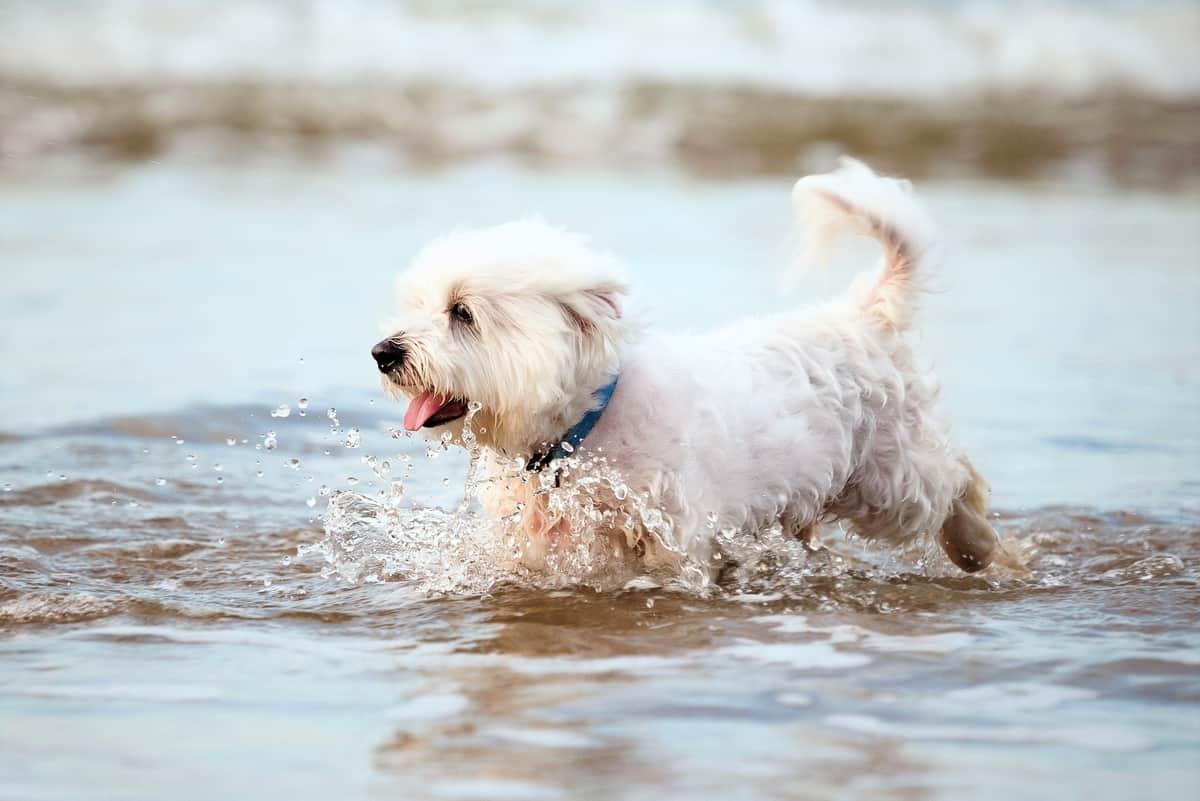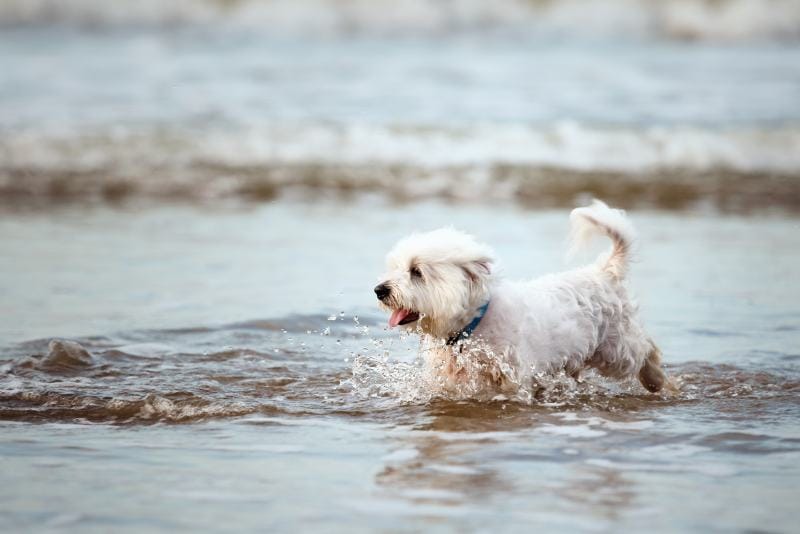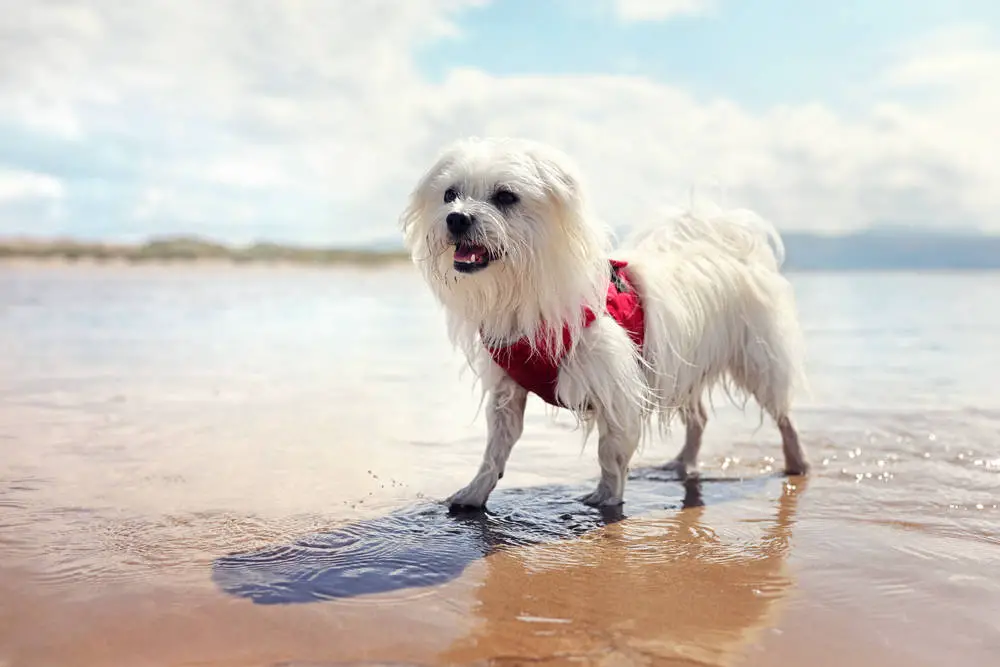Do Maltese dogs have a knack for swimming? It's a question that many pet owners may wonder, especially if they are considering taking their furry friend to the beach or letting them enjoy a dip in the pool. And while Maltese dogs are known for their luxurious coats and elegant demeanor, their swimming abilities may not be as adept as some other breeds. Maltese dogs are generally not natural swimmers due to their small size, short legs, and low body fat. The combination of these factors makes it challenging for them to stay afloat for extended periods.

However, that doesn't mean they can't enjoy the water! With the right precautions, such as wearing a life jacket and closely supervising their time in the water, Maltese dogs can still have fun splashing around. So, if you're planning a beach day or considering teaching your Maltese to swim, it's important to take their physical limitations into account and prioritize their safety above all else.
Understanding the Swimming Abilities of Maltese Dogs
Maltese dogs, originating from the Mediterranean island of Malta, were initially bred as companion dogs and were not specifically bred for swimming. Their small size and low body fat make it difficult for them to stay buoyant in water, unlike breeds that have been bred for water sports, such as Labradors or Retrievers. Additionally, Maltese dogs have short legs, which can make it challenging for them to paddle efficiently and propel themselves through the water. These factors combined mean that Maltese dogs are generally not natural swimmers.

Common Misconceptions about Maltese Dogs and Swimming
Despite their limitations in the water, there are some misconceptions about Maltese dogs and swimming. One common misconception is that all dogs can swim instinctively. While it's true that most dogs have a natural instinct to paddle their legs when placed in water, this does not mean that they are proficient swimmers. In the case of Maltese dogs, their natural swimming abilities are limited due to their physical characteristics. Another misconception is that all dogs enjoy swimming. While some Maltese dogs may enjoy being in the water, others may be fearful or uncomfortable. It's important to understand your dog's individual preferences and comfort level before introducing them to swimming activities.
Precautions to Take when Introducing a Maltese Dog to Water
When introducing your Maltese dog to water, it's crucial to take certain precautions to ensure their safety. One of the most important precautions is to always closely supervise your dog when they are in or around water. Even if your dog is wearing a life jacket, accidents can happen, and it's essential to be vigilant. Additionally, it's crucial to gradually introduce your Maltese to water and never force them into swimming if they are hesitant or anxious. Start by allowing them to explore shallow water and gradually increase the depth as they become more comfortable. Using positive reinforcement, such as treats or praise, can also help create a positive association with water.
How to Teach a Maltese Dog to Swim
While Maltese dogs may not be natural swimmers, with patience and proper training, they can learn to enjoy the water. The key to teaching a Maltese dog to swim is to take it slow and make the experience positive and rewarding. Start by introducing your dog to shallow water, such as a kiddie pool or a calm, shallow area of a lake or beach. Use a life jacket to provide extra buoyancy and support. Gradually encourage your dog to enter the water and paddle their legs. Offer treats and praise for their efforts. Over time, your Maltese may gain confidence and become more comfortable in the water. It's important to remember that not all Maltese dogs will become proficient swimmers, and it's essential to respect their individual abilities and comfort levels.
The Benefits of Swimming for Maltese Dogs
While swimming may not come naturally to Maltese dogs, there are several benefits to incorporating water activities into their routine. Swimming is a low-impact exercise that can help keep your Maltese dog active and fit. The buoyancy of the water reduces stress on their joints, making it an ideal exercise for dogs with arthritis or other joint issues. Swimming can also help improve muscle tone and cardiovascular health. Additionally, water activities can provide mental stimulation for your Maltese, helping to alleviate boredom and prevent destructive behaviors. Just remember to always prioritize your Maltese's safety and well-being when engaging in water activities.
Fun Water Activities for Maltese Dogs
While swimming may not be the preferred activity for all Maltese dogs, there are other water activities that they may enjoy. Some Maltese dogs may enjoy playing fetch in the water, using a floating toy or ball. This allows them to cool off while still engaging in their favorite game. Another fun activity is sprinkler play, where you set up a sprinkler in the backyard and let your Maltese run through the water. This can be a great way to keep them entertained and active on hot summer days. Remember to always provide fresh drinking water and offer plenty of breaks and shade to prevent overheating.

Products and Gear for Swimming with Maltese Dogs
When engaging in water activities with your Maltese dog, there are several products and gear options that can enhance their safety and enjoyment. One essential item is a well-fitted life jacket designed specifically for dogs. A life jacket provides extra buoyancy, ensuring that your Maltese stays afloat even if they become tired or encounter rough waters. Additionally, a life jacket makes it easier to spot your dog in the water and provides a handle for lifting them out if needed. Another useful item is a waterproof collar or harness, which can be helpful for attaching a leash or identification tags during water activities. Finally, don't forget to pack plenty of towels to dry off your Maltese after their water adventures.
Common Myths About Maltese and Swimming
Exploring common myths is crucial to dispel misconceptions about Maltese dogs and swimming. Let's separate fact from fiction to ensure you make informed decisions about your furry friend's aquatic adventures.
Myth 1: Maltese dogs are natural-born swimmers.
Contrary to popular belief, not all Maltese dogs are natural swimmers. While some may take to water with ease, others may need patient introduction and positive reinforcement.
Myth 2: Swimming ruins the Maltese coat.
Maltese dogs are known for their luxurious white coats, and there's a misconception that swimming damages their fur. Learn how to properly care for their coat post-swim and debunk this common myth.
Myth 3: Allowing a Maltese to swim leads to health issues.
Some believe that swimming poses health risks for Maltese dogs. We'll delve into the truth behind this myth, discussing the benefits of controlled water activities for their overall well-being.
Myth 4: Maltese puppies instinctively know how to swim.
While many puppies have a natural affinity for water, it's not a universal truth for Maltese pups. Uncover the realities of introducing your Maltese puppy to swimming and nurturing a positive experience.
Choosing the Right Water Environment
Ensuring a suitable water environment is essential for your Maltese dog's safety and enjoyment. Let's explore the factors that contribute to an ideal setting for your furry companion to take a dip.
Consideration 1: Shallow and Calm Waters
Maltese dogs, especially those new to swimming, benefit from shallow and calm waters. Avoid strong currents or deep areas to build their confidence gradually.
Consideration 2: Temperature Matters
Maltese dogs can be sensitive to extreme temperatures. Learn about the optimal water temperature for your furry friend, ensuring they stay comfortable and safe during their aquatic adventures.
Consideration 3: Familiarity with the Environment
Introduce your Maltese to the water gradually. Familiarize them with the surroundings before encouraging swimming, creating a positive association with the chosen water environment.
Consideration 4: Safety Measures
Implement safety measures such as life vests designed for small breeds. These precautions ensure your Maltese is protected while enjoying their time in the water.
Consideration 5: Positive Reinforcement
Reward positive behaviour with treats and praise. Associating swimming with positive experiences helps your Maltese feel more comfortable and eager to engage in water activities.
By dispelling myths and considering the right water environment, you can make swimming a delightful experience for your Maltese companion.
Recognising Signs of Discomfort

Understanding your Maltese companion's body language is crucial when engaging in water activities. Dogs may not express themselves verbally, so being attuned to their non-verbal cues is essential for a positive swimming experience. Here are key signs to recognise if your Maltese is uncomfortable in the water:
1. Paw Paddling Resistance
- If your Maltese resists paddling or constantly lifts their paws out of the water, it might indicate discomfort or uncertainty. Observe their reactions to determine their comfort level.
2. Tensed Body Language
- A tense body suggests anxiety. Look for signs of rigidity, especially in the neck and back muscles. A relaxed dog is more likely to enjoy the water, so pay attention to any signs of stiffness.
3. Excessive Shaking
- While a bit of shaking is normal to get rid of excess water, constant shaking can be a sign of discomfort or stress. If your Maltese shakes excessively, consider taking them out of the water and providing reassurance.
4. Wide Eyes and Dilated Pupils
- Wide eyes and dilated pupils are classic signs of stress in dogs. If your Maltese exhibits these, it's an indication that they may be feeling overwhelmed. Give them time to adjust and ensure a gradual introduction to water.
5. Whining or Vocalisation
- Unusual vocalisation, such as whining or whimpering, can be a clear sign of distress. If your Maltese expresses discomfort vocally, it's crucial to respond promptly by removing them from the water and offering comfort.
6. Attempting to Climb Out
- If your Maltese consistently tries to climb out of the water or onto elevated surfaces, they might be communicating a desire to exit the swimming environment. Listen to their cues and respect their boundaries.
7. Avoidance Behaviour
- Maltese dogs may display avoidance behaviour, such as turning away from the water or trying to move to shallower areas. Recognising these signs helps you gauge their comfort level and adjust accordingly.
8. Hiding or Seeking Shelter
- If your Maltese seeks shelter or attempts to hide, it's a sign of discomfort. Provide a safe space and evaluate whether your happy dog is ready for more gradual water introductions.
By observing and understanding these signs, you can ensure that your Maltese feels secure and content during water activities. Paying attention to their comfort levels fosters a positive association with swimming, making it an enjoyable experience for both you and your furry friend.
Conclusion
While Maltese dogs may not be natural swimmers, they can still enjoy water activities with the right precautions and training. It's important to understand their limitations and take steps to ensure their safety, such as using a life jacket and closely supervising their time in the water. Swimming can provide numerous benefits for Maltese dogs, including exercise, joint health, and mental stimulation. However, it's essential to respect your dog's individual comfort level and abilities. Whether it's a day at the beach or a game of sprinkler play in the backyard, there are plenty of ways to have fun in the water with your Maltese companion. Just remember to prioritize their safety and enjoyment above all else.

Frequently Asked Questions about Maltese Dogs and Swimming
1. Can all Maltese dogs swim?
Not all Maltese dogs are natural swimmers. Their small size, short legs, and low body fat make swimming more challenging for them compared to breeds specifically bred for water sports.
2. Do Maltese dogs need to wear a life jacket when swimming?
While not all Maltese dogs require a life jacket, it is highly recommended to ensure their safety, especially if they are still learning to swim or are in unfamiliar waters.
3. How can I keep my Maltese dog safe when swimming?
To keep your Maltese safe when swimming, always supervise them closely, use a life jacket, gradually introduce them to water, and be aware of their comfort level and limitations.
4. Are there any water activities that Maltese dogs can enjoy besides swimming?
Yes, some Maltese dogs may enjoy playing fetch in the water or running through a sprinkler. It's important to find activities that your dog enjoys and feels comfortable with.
5. Can swimming be beneficial for Maltese dogs?
Yes, swimming can provide low-impact exercise, improve muscle tone, and provide mental stimulation for Maltese dogs. However, always prioritize their safety and well-being.




